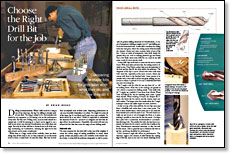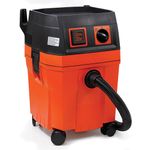Choose the Right Drill Bit for the Job
Comparing the major bits for precision work: what they do, and how they do it
Synopsis: Drilling clean, accurate holes should be simple, but selecting the right bit for the job can be complicated. Chairmaker Brian Boggs breaks down the field and explains the anatomy of each bit – how it is designed and how the design affects performance, so that you can find the bits that best cover the range of your drilling needs. You’ll learn the advantages, limitations, and best uses for twist-drill bits, brad-point bits, Forstner and multispur bits, Powerbore bits, auger bits, and spoon bits.
Drilling is serious business. When I drill a hole for a rung in one of my chair legs, the leg I’m drilling is already sanded and oiled. The rung is turned to fit. Any mistake now would be very expensive, so I’m betting a lot on the performance of my drill. But why not? Drilling clean, accurate holes should be a simple task. A drill bit spinning in a chuck can be jigged to cut a hole in just about any material woodworkers use at just about any angle. But with all of the drill bits to choose from in all of the catalogs overloading our bookshelves, selecting the right bit for the task at hand can be pretty complicated.
While there is a huge variety of bits available, there are three things that all bits need to do: (1) Stay centered; (2) cut the wood loose to form a round hole; (3) eject the chips. Bits vary in how they accomplish each of these tasks. Improving performance in one area invariably diminishes it in others. No single bit covers all of the bases, but it’s not likely you’ll need every type available. To know which bit to use when, I think it’s important to understand the anatomy of each bit—just how it is designed and how that design affects its performance. Hopefully, this article will steer you toward the bits that best cover the range of your drilling needs.
Twist-drill bits
The most common bit, the twist drill, is also one of the simplest. It covers the widest range of cutting possibilities in wood, sheet goods, metals and plastics and is also available in the widest variety of sizes. A twist-drill bit performs adequately or well in practically all general drilling situations for woodworkers. A couple of exceptions: drilling at angles over 45° and drilling perfectly fiat-bottomed holes. A twist drill is excellent for cutting holes into end grain, where the cutting action of the bit yields the cleanest, fastest and most accurate holes of any of the bits. I keep an index of inexpensive twist drills handy for general shop use, such as making plywood jigs and forms. And a few finely tuned twist drills live on a rack by my drill press, ready for more precise work.
A twist drill’s lips work both to center the bit and to cut the wood.
From Fine Woodworking #138
For the full article, download the PDF below:
Fine Woodworking Recommended Products

Estwing Dead-Blow Mallet

Fein Turbo II HEPA Wet/Dry Dust Extractor

Stanley Powerlock 16-ft. tape measure





















Log in or create an account to post a comment.
Sign up Log in